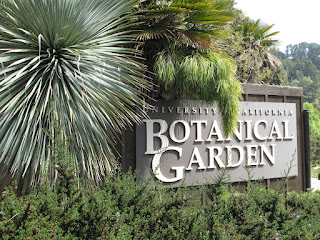Yesterday, I was lucky enough to spend time with two very
special mothers: mine and big mama nature. We took my mom to the
University of California Botanical Gardens, which grows an extraordinary collection of plants
from all over the world.
The plants are organized by region, and walking through the different
landscapes is like going on the It’s A Small World ride of the plant kingdom. We began in Southern Africa and saw some of the most bizarre and coolest plants.
 |
This cycad looked like it had a pineapple base, succulent
leaves and a pine cone growing out of the middle.
Apparently, cycads, which are scarce now, used to
dominate the landscape during dinosaur times. |
 |
This sweet plant from the western cape province of South Africa
had little Christmas tree lights around the edges of its leaves. |
 |
| This one, from Namibia, was a little intense. |
The we moved on to the Mediterranean...
 |
At first I thought this plant from southern Europe was
covered in bugs, but it turns out it produces a growth
from the center of each leaf. |
 |
| There were plenty of succulents. |
 |
And this beauty from the Canary Islands, with its bright yellow
flower and red stems. |
We eventually found our way into the Crops of the World Garden (!) where crops were organized according to their country of wild origin and paired alongside one another to minimize the spread of pests and diseases.
 |
| Cool purple pea |
Among the things I learned: artichokes and melon have wild origins in Africa; peanuts are from South America; carrots and oranges come from Asia; and apples, lettuce and spinach all come from West Asia/the Near East.
After traipsing through Australasia, we landed in the Chinese Medicinal Herb garden, a collection of over 100 herbs used in traditional Chinese medicine. The herbs are arranged by function group (16 total, including purging herbs, herbs for warming interior and eliminating cold, and herbs for pacifying the spirit) which are used to restore balance through holistic means. All I can say about these is: I want to learn more, and also I wanted to eat them (but you're not supposed to, and I didn't).
 |
| Nature's antibiotic? |
The Chinese herbs fed into the main(stream) herb garden, where the bees were having a field day! (Wait, is that why they call it that?)
 |
| As seen here on spiderwort... |
 |
| and comfrey. |
We ended our journey with a stop in the Arid House, home to a gazillion different cacti and succulents. If I were having a plant party, these guys would all be invited...
 |
| From Mexico |
 |
| Brazil |
 |
| Argentina |
 |
| Namibia |
 |
| and Peru. |
So much personality. This guy might also get invited:
We spent a few hours here, but didn't even get to the bamboo grove, the cloud forest, the redwood grove, the tropical house, the xerophytic fern display, Mexico and Central America, Eastern North America, the section on California that features 1,200 plant species, "almost one quarter of all species in the state." And how is it possible that I've lived in the Bay Area on-and-off my whole life and didn't even know that "California has greater biotic diversity than any other state...and contains 44% of the world's plant species?"
44%?
What can I say? I'm lucky to live in such a flourishing state, near an incredible collection of plants and just a few miles away from my mom, who enjoys ogling these guys as much as I do. Thanks mom!


















Comments
Post a Comment